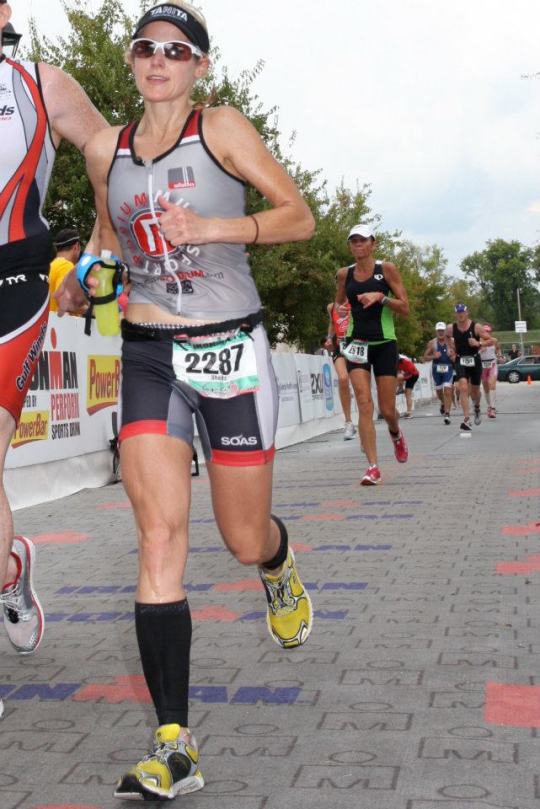By Sheila Howard
Editors note: this is part one of a two part blog.
This is not quite the blog I was hoping to write. Augusta 70.3, the 2015 edition was not the race I’d hoped or planned to have. But such is life, and part of what makes triathlon so compelling is the quest to conquer a course and a race that has gotten the better of us in the past.
Augusta 2011 was the race that got the better of me. Only two years into the sport and still experimenting with nutrition, I decided to go with all gels on the bike. I taped a handful of gels to my top tube, but did a lousy job of taping! When I pulled off the first gel 10 miles into the bike, all the other gels fell off! Oops!! Typically, I would need 600 to 650 calories for a Half Ironman bike leg and instead had 200. This predictably caught up with me on the run. I held on for the first run loop at just under a nine minute pace but was eventually reduced to a walk.

Sheila nearing the end of Augusta 70.3 in 2011.
Augusta 2015 was going to be different, better, decisive. Leading up to the race, I had two injuries and
an infection that wasn’t responding to antibiotics. My doctor finally used a series of antibiotic injections to knock it out within two weeks of the race. I’d seen an orthopedic and a PT for both a hip issue and a problem with the tibial tendon in my left foot.
It became clear the race may not be my best after all. I adjusted my goals and hoped for a decent time. Now, looking back on what was a disappointing race day and my PW (personal worst) time at the Half Ironman distance, the experience still gave me some unexpected and wonderful memories and taught me several lessons for future races.
Here are a few things I learned from this race, and from my past season.
NEGLECTING OFF-SEASON STRENGTH WORK OR EARLY SEASON TRAINING CAN COME AT A PRICE IN PEAK PERFORMANCE FOR YOUR “A” RACE
This header is ideally a warning, a friendly word to the wise in planning your training and race season. But I’m writing this at the end of the season to confirm that yes, strength work and consistent training may seem optional and challenging to schedule during an off-season, but we skip them at our own risk.
I’ve always done off-season strength training. We’ve all probably read articles that say functional strength training can help prevent injury in our regular season training and racing. Let’s just say as you get up into masters age groups, these disciplines pay increasing dividends as your seasons progress. Apart from a bike crash a few years ago, this is the first season I’ve dealt with this level of injury. The injuries created ongoing pain and adversely affected my training and racing schedules leading up to my A race. Both issues were “overuse” injuries that strength training in the off-season could have helped prevent. Due to work and out-of-town obligations from February to May, I started training near the end of May without laying the groundwork of strength or base training.
ON THE BIKE — POWER DOESN’T LIE, AND RACE WEIGHT MATTERS.
In part, because I lacked any training consistency in the off- season, started training late and tried to make up for lost training time, the obvious happened. Though my numbers were improving, and I was progressing toward my goals, I didn’t have enough time on the calendar before Augusta 70.3 to get light enough, fit enough and to reach my target power on the bike. Power doesn’t lie. In early September, with less than a month to go, I saw the writing on the wall, given my power data on training rides and comparing it to previous seasons.
When you train on the same bike courses year after year, with a power meter, you have historical data that, especially paired with your race weight and other metrics, gives you a good idea of where your fitness and performance may stack up on race day, relative to your goals. My power was a little low,
and my weight was a little too high to be where I wanted to be on the bike. I was able to estimate within a couple of minutes what my bike time would be in the race, given these data points.


 SWIM
SWIM
 BIKES
BIKES
 APPAREL
APPAREL
 NUTRITION
NUTRITION
 COMPONENTS
COMPONENTS
 ACCESSORIES
ACCESSORIES
 Podium Multisports Blog
Podium Multisports Blog









